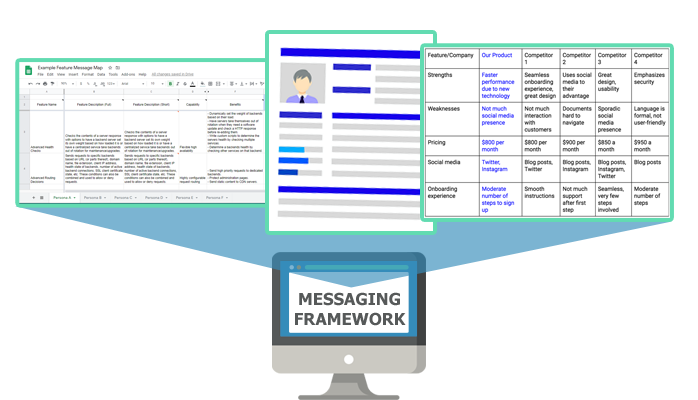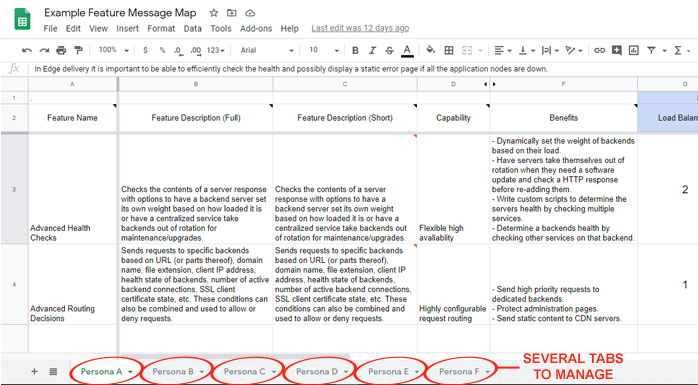
Why Are You Always Looking for a New Messaging Framework? Something wrong with yours?
Jonathan Bracken
If the post title is what led you here, there’s a good chance you’re on the hunt for a new messaging framework. And if you’re like me, it’s probably not the first time you’ve looked for something “better” in that regard. This is normal – as your company/product matures, so should your marketing (also, 2+2=4, the sky is blue, and grass is green).
For many of us, trends like increased targeting, value messaging, and account-based marketing necessitated a search for better ways to organize our messaging. The fact is, there are a lot of decent messaging frameworks out there, and they all offer an exciting glimpse of a promising, though untested, future.
Welp, I’ve had enough glimpses to determine one thing: most of these frameworks are deeply flawed.
And we’re not talking about little things like failing to provide instructions for each message and relevant examples, no. These flaws are more fundamental – and when I bought into these frameworks, their shortcomings led to my failure to deliver on the key objectives of our product marketing messaging.
What exactly do we need from our new framework?
At the highest level, our marketing messaging objective is to communicate what we do, the value of it (our product/service), and for whom. To be effective, this communication should be CONSISTENT and TARGETED.
The same goes for your B2B messaging framework. In order for your framework users to find and utilize the right message at the right time for the typical myriad use cases (e.g. content briefs, demand gen campaigns, sales emails, etc.), your messaging framework must be CONSISTENT and TARGETED as well as easy to use.
CONSISTENT Messaging Framework
- All of your messaging needs to be written in a consistent way. Deviations from this approach cause confusion for your audiences and can lead to visitors “bailing out” on the experience of learning more about what you do and how it can be of benefit. Your feature descriptions should all have the same structure, benefits should all be written the same way, etc.
- If you have the same message used in different places, it should be the same. For example, a feature for persona A that is also important to persona B should always have the same description. Though each persona may care about different benefits related to that feature, it performs the same action for both. This means your messaging framework needs to be meticulously maintained to ensure any duplicate messages that are used for different audiences or contexts are all updated at the same time.
TARGETED Messaging Framework
- You need to write messaging that helps explain to each of your intended audiences what it is that your product can provide of value to them. This is all messaging 101 stuff, and most companies start with basic messaging that goes to everyone. Over time, they’ll develop deeper levels of targeted messaging to fit their business needsㅡfor example, adding additional buying personas, industry targets, and/or messaging for specific competitive situations or particular stages of the buyers’ journey. Your messaging framework must be able to support each additional layer of targeting, no matter how deep that hole goes.
So here’s what’s wrong with existing messaging frameworks: they make it unnecessarily difficult to create and maintain CONSISTENT and TARGETED messaging. Generally, they do this by failing in the structure, tools, and oftentimes both.
The Structure Problem in Messaging Frameworks
The “Structure” problem arises as a byproduct of the way messaging frameworks are typically adopted by companies. Usually the adoption of a new framework is in response to a specific area of need that has been identified. It’s not so much that there’s a driving force to create an all-encompassing framework, but rather there’s a single, specific challenge to address.
- “We need to create personas…what’s a good framework for that?”
- “How about we do ‘features/ benefits and advantages’?”
- Maybe it’s just a company-level brand messaging initiative or an effort to create industry docs for when you want to verticalize
The result is that each new framework piece we choose is optimized for that specific area of need. And then it gets stuck together with the other frameworks that have been previously adopted. Even if you tried to get an all-encompassing messaging framework, most messaging framework templates don’t contain all the elements you need, so you’d still be required to cobble together multiple frameworks:

This results in a sort of franken-framework that’s basically a collection of documents with redundant elements, conflicting styles, and different formats (docs, slides, sheets, wikis, etc.).
The problem is that you end up with multiple frameworks that are not well integrated. This lack of integration forces you to maintain duplicate messages across multiple frameworks, and you end up spawning additional core messaging docs to cover desired intersections.
For example, I’ve often seen things like features, benefits and advantages replicated across personas that held any in common. This duplicate messages issue becomes more and more difficult to manage as you add dimensions to your messaging framework. Even a small B2B software company with a single product can find their framework getting unwieldy if they target by persona and industry.
The Tools Problem in Messaging Frameworks
The second problem with most messaging frameworks is simply the tools used to create the framework(s). Whether you use sheets, Airtable, docs, slides or wikis, all have their advantages, but they also have some significant disadvantages that can be problematic.
Docs and Wikis
Docs and wikis have almost limitless flexibility in terms of what you can put in it, but the format struggles when you want to maintain the relationships between things.
Let’s say you’re dealing with which features are most relevant for each persona. Usually in a doc you’ll have one framework template for personas and another for features and benefits. Your “messaging bible” ends up being a lengthy collection of messaging templates that have few (if any) relationships defined between elements.
When you want to show messages that have an intersection across these templates, like features and benefits for a specific target audience, the messages will often be duplicated in order to show the common features and benefits for persona A and then again for persona B. It gets really mucky when you want to add in layers like challenges/pain points, stage of buyers cycle, industry, competitive situation, etc….
This format still has some value, especially as a training tool, but it’s very difficult to use for someone trying to find the right messages for a particular situation. These “messaging bibles” are then ignored by would-be users because they can’t be relied upon for quick, easy answers to the constant flow of questions about “what messaging should I use for X situation?” The challenges of keeping these up to date also means they rarely are; they get stale quickly and stay that way until the next messaging framework rollout.
Sheets and Airtable
Sheets, on the other hand, can map relationships between your messaging framework elements. For example, you can map features to benefits and advantages. Unfortunately, the format of sheets makes it harder to read than a doc or wiki and the relationships are still limited in dimensionality.
If you were trying to show features to benefits to advantages to personas to industries, it would be pretty hard to do in a sheet…or even in a workbook. Similar to what happens in the doc/wiki approach, you end up needing to duplicate fields or create complex cell references. It may not be impossible, but at some point the complexity of maintaining it and/or the difficulty in using it makes it fail.
Airtable has its fair share of benefits and does some things you can’t do in sheets, however, it too fails to adequately handle the ability to filter down to the right subset of messages that you need for any situation. Sheets (or even better, Airtable) are great if you don’t have much complexity in your messaging. But if you’re trying to get more targeted and are adjusting your messaging for each audience, you’ll run into challenges pretty quickly unless you have a lot of people to manage it.

Slides
Slide decks are great in terms of their presentability (unsurprisingly). You can easily merge text with images or graphics to support the telling of the message. Plus, you can organize it in whatever way you want.
But slide decks offer less dimensionality than the other formats, including docs, since slides are even more divided in terms of organization (generally with ~one idea per slide.)Typically, it’s been very difficult to efficiently convey not only the messaging, but also the relationships between messages by using slides.
You’ll generally need to segment slide decks (or sections) for each target audience which, again, requires you to duplicate messages that are shared with other target audiences.

Summary
Finding the “right” new messaging framework is a difficult enterprise. Despite seeming to hold the potential to fix your immediate need, the challenges posed by structure and tool shortcomings conspire to make most messaging frameworks fail.
As a result, you spend way too much time on maintenance and simultaneously suffer from the lack of a ‘single source of truth’ for messaging. This all but ensures those one-off questions keep pouring into PMM teams as your internal consumers seek to find the “right” messages for each specific situation.
In short, these frameworks don’t age well. So we try and try again, but never quite seem to find a messaging framework that has the ability to stand the test of time. Fret not and see our post on choosing the right elements for the essential messaging framework.